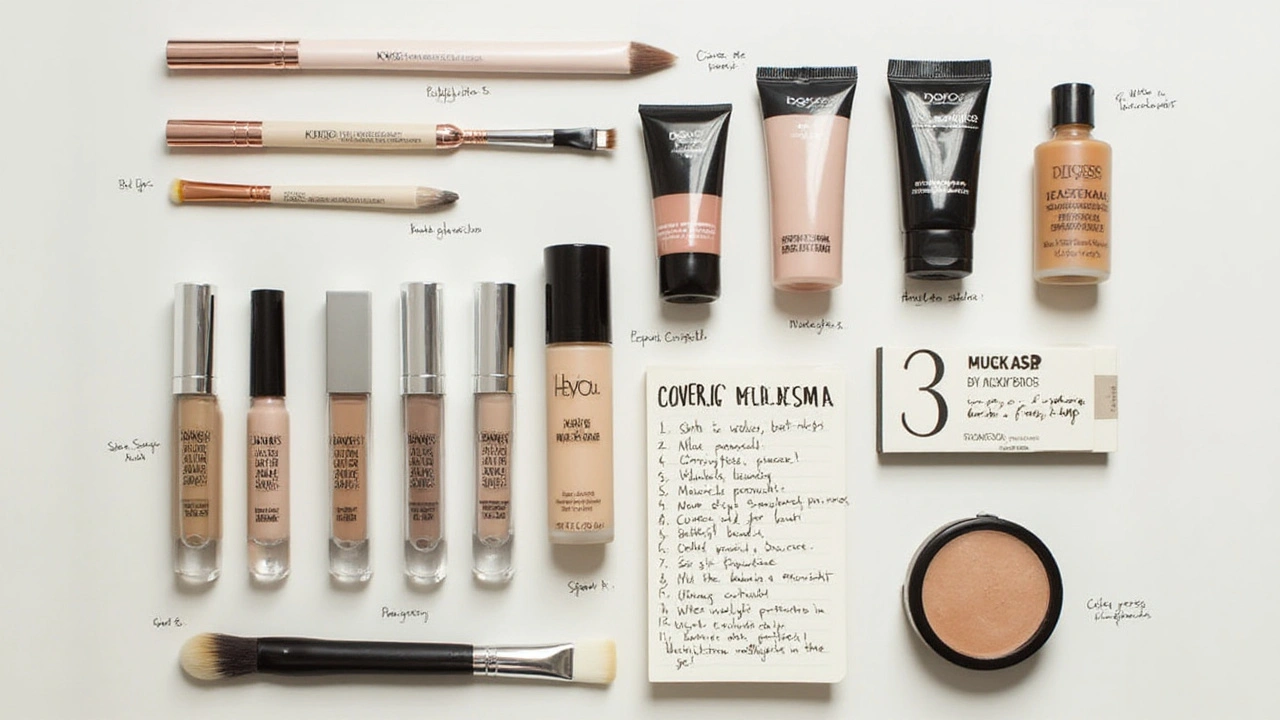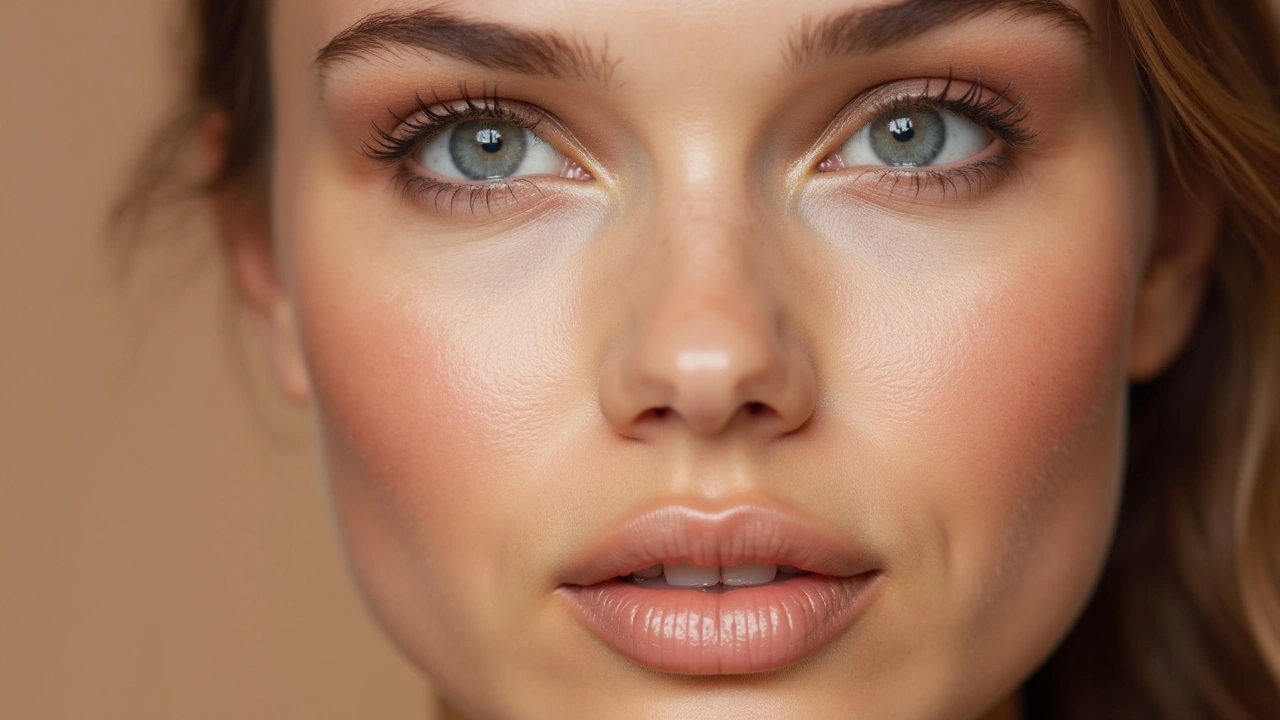Melasma, those pesky dark patches mostly on the face, can be quite a challenge to cover. But the good news is that makeup can work wonders when done right. Whether you're getting ready for a special occasion or just want to feel more confident daily, some strategic steps can make a huge difference.
Before diving into the world of concealers and foundations, it's crucial to understand melasma and how your skin reacts to different products. This understanding will guide you in choosing the best makeup for your needs.
With the right preparation, techniques, and products, you can achieve a seamless finish that masks melasma effectively. Ready to start? Let's explore how you can master the art of covering melasma with makeup.
- Understanding Melasma
- Prepping Your Skin
- Choosing the Right Products
- Application Techniques
- Setting Your Makeup
- Maintaining Your Look
Understanding Melasma
Melasma is a common skin condition marked by dark, discolored patches on the face, especially on the cheeks, forehead, nose, and upper lip. Its exact cause isn't fully understood, but it often appears due to hormonal changes, sun exposure, and even genetic factors. Women, particularly those who are pregnant, taking birth control pills, or undergoing hormone replacement therapy, are more susceptible.
The pigment-producing cells in the skin, called melanocytes, become hyperactive and produce more melanin than usual. This overproduction leads to the characteristic brown or grey-brown patches. If left untreated, these patches can become permanent, though they often fade with the right treatment and preventive measures. Studies suggest that up to 33% of the population suffers from melasma at some point in their lives, so it's quite a widespread issue.
Interestingly, melasma is not just skin-deep; it can affect people's self-esteem and confidence. A study published in the Journal of the American Academy of Dermatology found that many individuals experiencing melasma feel self-conscious and may even avoid social situations. Such emotional impacts underline the importance of effective cosmetic solutions.
According to Dr. Amy Derick, MD, a board-certified dermatologist, "Melasma can be managed effectively with a combination of topical treatments and sun protection. Makeup is an excellent tool for people looking to conceal these patches while undergoing treatment."
People with melasma should focus on a skincare regimen that minimizes sun exposure and incorporates products designed to lighten hyperpigmentation. Physical sunscreens containing zinc oxide or titanium dioxide are particularly effective as they provide a shield against both UVA and UVB rays. Additionally, topical treatments containing ingredients like hydroquinone, kojic acid, and vitamin C can help in lightening the dark patches.
It's also vital to know what triggers melasma to avoid recurrent flare-ups. For example, heat and light, not just direct sunlight, can exacerbate the condition. Even hot yoga or cooking over a stove might make the patches more prominent. Therefore, those dealing with melasma should strive to stay cool and protect their skin as much as possible.
Prepping Your Skin
Before you even think about picking up your melasma makeup, you need to make sure your skin is well-prepped. Think of it as laying a foundation for a house; without it, everything else will crumble. A good skincare routine is essential for anyone, but it's especially vital if you're dealing with melasma. This step helps create a smooth, even canvas, making the application of makeup much easier and more effective.
First things first, always start with a clean face. Wash your face with a gentle cleanser that's suitable for your skin type. Steer clear of anything too harsh; you've already got enough on your plate without adding irritation to the mix. After rinsing, gently pat your face dry with a soft towel. This helps reduce redness and prepares your skin to absorb the following products better.
Exfoliation is the next crucial step, but it needs to be done carefully. Use a mild exfoliant to slough off dead skin cells and promote a smoother texture. Over-exfoliating can cause your skin to become sensitive and worsen melasma, so stick to exfoliating 2-3 times a week. Look for products containing alpha hydroxy acids (AHAs) or beta hydroxy acids (BHAs) as these are effective yet gentle.
After exfoliating, hydration is key. A well-hydrated face helps in the application and longevity of makeup. Use a good moisturizer that suits your skin type. Products containing hyaluronic acid are fantastic for providing deep hydration without feeling greasy. Just make sure whatever you choose is non-comedogenic, to avoid clogging pores.
It’s also crucial to apply a good sunscreen every single day. Melasma can be aggravated by sun exposure, so protecting your skin is non-negotiable. Look for a broad-spectrum SPF 30 or higher. Recent studies have shown that sunscreens containing iron oxide are particularly effective in protecting against visible light, which is known to worsen melasma.
Using a primer specifically designed for your skin's needs can make a world of difference. Primers not only blur imperfections but also extend the wear of your makeup. Opt for color-correcting primers with a peach or orange tint to counteract the blue or gray tones often associated with melasma.
"A good primer can act like a spackle for makeup, filling in lines and creating a smooth surface," says celebrity makeup artist Lisa Eldridge.
Don’t forget to take care of your lips and eyes. Apply a hydrating eye cream to tackle puffiness or dark circles, and a nourishing lip balm to keep your lips soft and ready for color. These small steps can make a huge difference in how your makeup looks and feels throughout the day.
Now that you’ve laid down the groundwork, your face is a fresh, smooth canvas ready for makeup. Proper skin preparation can make the hardest part of your beauty routine a lot easier, helping your makeup stay on longer and look better. Remember, the key to covering melasma effectively starts with great skin care.

Choosing the Right Products
When it comes to melasma makeup, the first step is finding the right products. This means you need to opt for items that not only provide good coverage but also care for your skin. The goal is to look fabulous while being mindful of your skin's health. For starters, consider a color corrector. These products can neutralize the dark patches caused by melasma. For example, a peach or orange color corrector works wonders on darker skin tones, while a yellow corrector suits lighter skin.
After color correction, it's essential to choose a full-coverage foundation. Many beauty experts recommend foundations that are specifically designed for hyperpigmentation. Products like Dermablend's Flawless Creator or Estée Lauder's Double Wear are popular choices because they offer long-lasting coverage and a natural finish.
Concealer is another must-have in your toolkit. Make sure to pick a high-coverage, long-lasting concealer. Use a shade that matches your skin tone perfectly to avoid drawing attention to the areas you're trying to conceal. For instance, Tarte Shape Tape and MAC Pro Longwear are often praised for their exceptional coverage and staying power.
According to dermatologists, "Using makeup that contains ingredients like niacinamide and hyaluronic acid can provide additional skincare benefits while offering coverage."
Beyond foundation and concealer, you should also consider setting powders and sprays. A good setting powder like Laura Mercier Translucent Loose Setting Powder helps to lock in your makeup and keep it from settling into fine lines. Setting sprays like Urban Decay's All Nighter can increase the longevity of your makeup, ensuring it stays put all day long.
Additional Tips
Don't forget to incorporate SPF into your makeup routine. Melasma can worsen with sun exposure, so using a foundation or primer with built-in SPF can offer added protection. Look for products labeled with a minimum SPF 30. For instance, IT Cosmetics' Your Skin But Better CC+ Cream provides coverage along with SPF 50, making it a great dual-purpose product.
Finally, always conduct a patch test before trying new products, especially if you have sensitive skin. This helps in ruling out any potential allergic reactions. Sometimes, the wrong product can aggravate melasma, leading to more prominent patches. Sticking to brands that dermatologists recommend can minimize this risk.
| Product | Skin Benefit |
|---|---|
| Dermablend Flawless Creator | Full coverage, long-lasting |
| Estée Lauder Double Wear | Natural finish, long wear |
| Tarte Shape Tape | High coverage, long-lasting |
| MAC Pro Longwear | Exceptional coverage, stays put |
| Laura Mercier Translucent Powder | Locks in makeup, minimizes fine lines |
| Urban Decay All Nighter | Increases makeup longevity |
| IT Cosmetics Your Skin But Better CC+ Cream | Coverage with SPF 50 |
Application Techniques
When it comes to covering melasma with makeup, the application can make all the difference. Start with a clean, moisturized face as this will help the makeup adhere better and last longer. Use a primer that's specifically formulated to address skin discoloration; this will create a smooth base and help neutralize dark patches.
Next, select a color corrector. A peach or orange corrector works well on brown or grayish patches of melasma. Apply this in thin layers using a small brush or your fingertip, gently blending it into the skin. The aim here isn't to mask the area entirely but to neutralize the color difference.
After color correcting, it's time to apply foundation. Choose a full-coverage foundation that matches your skin tone. Use a damp makeup sponge or a foundation brush to apply it, starting at the center of your face and blending outward. This technique ensures a more natural look and avoids the heavy, cakey appearance.
To further conceal any areas where melasma is more prominent, use a high-coverage concealer. Opt for a product that has a creamy consistency as it blends more seamlessly into the skin. Dab the concealer onto the affected areas and blend it out with your fingertip or a small brush. Remember, less is more when it comes to concealer application.
Setting your makeup is essential for long-lasting wear. Use a translucent setting powder to lock everything in place. Lightly dust the powder over your entire face with a large, fluffy brush. If you have dry skin, use a setting spray instead to avoid the powdery finish and add a dewy glow to your complexion.
Blend, blend, and blend some more. Blending your makeup well can make a huge difference in the end result. Blend the edges of your foundation and concealer into your clean skin to ensure there are no harsh lines. When done right, your makeup should look like a second skin rather than a mask.
As Bobbi Brown, a renowned makeup artist, always says, "Makeup is a way for a woman to look and feel like herself, only prettier and more confident."Let this quote inspire you as you practice these application techniques for covering melasma.

Setting Your Makeup
Once you’ve meticulously applied your concealers and foundations, the next critical step is to set your makeup to ensure longevity. This is especially important for those attempting to cover melasma, as you don’t want the dark patches to gradually become visible throughout the day. Use a translucent setting powder to lock in your base without adding extra color. Dip a large, fluffy brush into the powder, then gently tap off the excess before applying. Lightly dust the powder across your face, focusing on areas where you’ve applied the most product.
Setting sprays can also be a game changer. After applying your powder, spritz a hydrating setting spray evenly across your face. Not only does this prolong the wear of your makeup, but it also helps to meld the layers together, giving you a more natural finish. Testers in various beauty labs have confirmed that setting sprays can extend makeup wear by up to 16 hours. If your skin's on the oily side, opt for a mattifying spray that controls shine throughout the day.
“A good setting spray can lock your look in from morning till night,” says Jillian Dempsey, a celebrity makeup artist who often works with clients dealing with skin pigmentation issues.
“It's all about finding a balance. Too much powder can look cakey, and too much spray can feel sticky. It's important to experiment and see what combination works best for your skin type,”she advises.
One sneaky trick many experts swear by involves blotting papers. Throughout the day, your skin can produce oils that break down makeup. Carry some blotting papers or a compact powder with you. When the skin gets oily, use the blotting paper to gently press on your face, removing excess oil without disturbing your makeup. This can be followed by a light dusting of setting powder for touch-ups.
Another important tip is to avoid touching your face. Our hands come into contact with numerous surfaces throughout the day, collecting dirt and oils which can transfer onto your face, negatively impacting your makeup. Being mindful can help keep your makeup intact. A recent study found that the average person touches their face over 20 times an hour, which can significantly smudge or transfer makeup, making the melasma visible.
Moreover, keep makeup setting products within reach during the day. A travel-sized version of your favorite setting spray or a compact powder can easily fit into your purse. This allows for on-the-go touch-ups and can help maintain your makeup even during long days.
Setting your melasma makeup is an art that, with the right products and techniques, can make a significant difference. Follow these tips, and you'll be well-equipped to keep your makeup looking fresh and flawless throughout the day.
Maintaining Your Look
Once you’ve achieved that flawless finish to cover melasma, the next step is maintaining it throughout the day. Understanding how to keep your makeup intact can make a world of difference. One of the first things to consider is using a good setting spray. Setting sprays help to lock your makeup in place, preventing it from smudging or fading. They are especially useful if you have long days or plan to be active.
Blotting papers can also be your best friend. If you have oily skin, it’s essential to manage excess oil as it can break down your makeup and reveal melasma patches. Keep a pack of blotting papers handy to dab away oil without disturbing your foundation. Be gentle and remember, blot—don’t rub.
Another handy tip is carrying a compact with a pressed powder that matches your foundation. Throughout the day, touch up any areas where the makeup might have worn off. Pay extra attention to the spots where melasma is most pronounced. Less is more when it comes to reapplication, so use a light hand.
According to makeup artist Lisa Eldridge, “Touching up makeup with the right product can make it last all day without caking or looking unnatural.”
It's also worth noting that keeping your skin hydrated is key. Drinking plenty of water keeps your skin looking fresh and less prone to dryness, which can make melasma more obvious. A good moisturizer used before makeup application and maintained throughout the day can keep your skin looking plump and your makeup looking smooth.
If you feel that your makeup is looking a bit dull, a quick mist of a hydrating facial spray can revive it. Look for sprays with ingredients like glycerin or hyaluronic acid to keep your skin looking dewy. These products provide a fresh look without adding more makeup layers.
On particularly sunny days, make sure to reapply sunscreen. There are makeup setting sprays and powders that contain SPF, which can be easily reapplied without ruining your look. Sun exposure can worsen melasma, so it’s crucial to stay protected.
A final tip for maintaining your makeup is to refrain from touching your face. It’s easy to forget, but frequent touching can transfer oils and dirt to your face, breaking down makeup. If you need to adjust anything, use clean hands or a brush.
Maintaining your look takes a bit of effort, but with these strategies, you can keep your melasma covered and your confidence high. Invest in quality products, keep hydrated, and stay mindful of sun exposure to have a flawless look all day long.





Phoebe Chico
When the skin sings its own storm of shadows, we stand at the crossroads of art and defiance.
In this great land of liberty, we wield pigments like flags, bold and unapologetic.
A dash of peach correction becomes a brushstroke of rebellion against the tyranny of melasma.
The ritual of prep, the careful layering, is a meditation on self‑sovereignty.
Remember, dear comrades, that confidence is the truest shade of freedom.
Larry Douglas
The article presents a comprehensive overview of melasma management through cosmetics.
It correctly identifies the importance of sunscreen in preventing pigment exacerbation.
The recommendation to use a color correcting primer aligns with dermatological best practices.
Selecting a full coverage foundation that also contains niacinamide provides dual benefits.
The suggestion to incorporate hyaluronic acid into makeup products supports skin hydration.
However the piece neglects to mention the potential irritancy of certain fragrance additives.
Users with very sensitive skin should perform a patch test before full application.
The table of product recommendations includes reputable brands known for longevity.
It would be prudent to also advise readers to consider non‑comedogenic formulas.
The step of gentle exfoliation two to three times weekly is sound advice.
Over‑exfoliation can indeed trigger post‑inflammatory hyperpigmentation.
The guidance on using blotting papers to manage oil without disrupting makeup is practical.
Readers should be reminded that touching the face repeatedly introduces bacterial load.
Maintaining proper hydration through oral water intake complements topical moisturizers.
In summary the article offers a solid framework that, with minor additions, could serve as an essential reference for individuals battling melasma.
Michael Stevens
I hear you, the journey with melasma can feel like a marathon without a finish line.
The step‑by‑step prep routine you shared really helps turn that marathon into a sprint.
Keep reminding yourself that every layer you apply is an act of self‑care.
If you ever need a buddy to swap product tips, I’m right here cheering you on.
Ann Campanella
Skip the pricey primers and just use a good concealer.
Desiree Tan
Listen up – you deserve a flawless canvas and you’ve earned the right to demand it!
Grab a peach corrector and smash that melasma like a warrior in battle.
Follow the prep routine to the letter or you’ll waste your time.
When you hit that setting spray, think of it as sealing a victory flag.
No excuses, just results!
Andrea Dunn
They don’t want you to know that the big pharma giants control the pigments in your makeup 😊.
That’s why they push lightweight formulas that fade the moment you step outside the lobby of a government building.
Use a full‑coverage foundation that also blocks the hidden UV rays from surveillance drones.
Keep an eye on the ingredients list, they’re watching you.
Stay safe and stay covered 🙃.
Erin Johnson
Oh wow, another guide on covering melasma – because the world was clearly lacking in that department.
Let’s applaud the heroic effort of suggesting a “peach corrector” as if it were a miracle potion.
Of course, the holy grail is a foundation that also functions as a sunscreen, because why not expect a single product to solve everything?
The tip about blotting papers is practically groundbreaking.
In the grand theater of beauty, this article merely hands out backstage passes.
Rica J
Hey, i love the step by step guide but kinda wish they mentioned more affordable options.
Some of the brands r pricey af, ya know?
Also, using a hydrating spray during the day is a lifesaver for dry skin.
Dont forget to reapply sunscreen if you’re out long.
Linda Stephenson
We all walk different paths when it comes to skin care and that’s totally okay.
Sharing tips like this helps us build a supportive community where nobody feels left out.
Remember to listen to your skin and adjust the routine if something feels off.
It’s cool to experiment but always keep that gentle vibe.
Together we can make melasma less of a barrier and more of a shared experience.